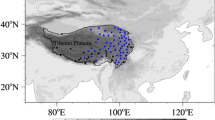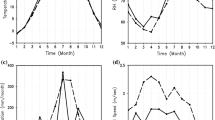Abstract
Unresolved small-scale orographic (SSO) drags are parameterized in a regional model based on the Global/Regional Assimilation and Prediction System for the Tropical Mesoscale Model (GRAPES TMM). The SSO drags are represented by adding a sink term in the momentum equations. The maximum height of the mountain within the grid box is adopted in the SSO parameterization (SSOP) scheme as compensation for the drag. The effects of the unresolved topography are parameterized as the feedbacks to the momentum tendencies on the first model level in planetary boundary layer (PBL) parameterization. The SSOP scheme has been implemented and coupled with the PBL parameterization scheme within the model physics package. A monthly simulation is designed to examine the performance of the SSOP scheme over the complex terrain areas located in the southwest of Guangdong. The verification results show that the surface wind speed bias has been much alleviated by adopting the SSOP scheme, in addition to reduction of the wind bias in the lower troposphere. The target verification over Xinyi shows that the simulations with the SSOP scheme provide improved wind estimation over the complex regions in the southwest of Guangdong.
摘 要
我国幅员辽阔, 地形复杂多样, 海陆边界线长, 地形对我国, 东亚乃至全球的天气和气候都有重要影响. 在模式物理过程中如何将这些次网格地形效应充分有效地加以描述, 对提高模式对复杂地形下气象要素预报能力有非常重要的科研和应用价值. GRAPES区域模式是我国自主研发的中尺度数值模式, 目前用于对华南地区的天气业务预报和科研工作. 针对GRAPES模式对复杂地形下风速预报偏强问题, 我们在动量平衡方程中增加一动量沉积项, 并在模式第一层中考虑此拖曳对风场的影响, 并设计了若干试验加以验证与改进. 其中, 对拖曳项与地形相关参数的计算, 取相邻格点地形高度最大值, 由此减少在静态数据初始化因网格平均法对拖曳力计算的低估. 对2016年5月19日的一次粤西特大暴雨个例研究及该月的批量试验结果表明, 该地形拖曳参数化能有效减少模式对风速的预报误差. 对2016年5月的批量试验结果表明, 该方案对地面风速的预报有明显的改进. 其中, 24小时和48小时的风速均方根误差分别有原来的4.01 ms-1 和4.76 ms-1 降低至1.02 ms-1和1.66 ms-1. 表明该方案能有效降低模式对地面风速的预报误差, 提高了模式对地面风速的整体预报能力.
Similar content being viewed by others
References
Belcher, S., and N. Wood, 1996: Form and wave drag due to stably stratified turbulent flow over low ridges. Quart. J. Roy. Meteor. Soc., 122, 863–902, https://doi.org/10.1002/qj. 49712253205.
Beljaars, A. C. M., A. R. Brown, and N. Wood, 2004: A new parametrization of turbulent orographic form drag. Quart. J. Roy. Meteor. Soc., 130, 1327–1347, https://doi.org/10.1256/qj.03.73.
Bossuet, C., M. Déqué, and D. Cariolle, 1998: Impact of a simple parameterization of convective gravity-wave drag in a stratosphere-troposphere general circulation model and its sensitivity to vertical resolution. Annales Geophysicae, 16: 238–249, https://doi.org/10.1007/s00585-998-0238-z.
Cheng, W. Y. Y., and W. J. Steenburgh, 2005: Evaluation of surface sensible weather forecasts by the WRF and the Eta Models over the western United States. Wea. Forecasting, 20, 812–821, https://doi.org/10.1175/WAF885.1.
Choi, H. J., and S. Y. Hong, 2015: An updated subgrid orographic parameterization for global atmospheric forecast models. J. Geophys. Res., 120, 12 445–12 457, https://doi.org/10.1002/2015JD024230.
Choi, H. J., S. J. Choi, M. S. Koo, J. E. Kim, Y. C. Kwon, and S. Y. Hong, 2017: Effects of parameterized orographic drag on weather forecasting and simulated climatology over East Asia during boreal summer. J. Geophys. Res., 122, 10 669–10 678, https://doi.org/10.1002/2017JD026696.
Fiedler, F., and H. A. Panofsky, 1972: The geostrophic drag coefficient and the ‘effective’ roughness length. Quart. J. Roy. Meteor. Soc., 98, 213–220, https://doi.org/10.1002/qj. 49709841519.
Georgelin, M., and Coauthors, 2000: The second COMPARE exercise: A model intercomparison using a case of a typical mesoscale orographic flow, the PYREX IOP3. Quart. J. Roy. Meteor. Soc., 126, 991–1029, https://doi.org/10.1002/qj. 49712656410.
Gesch, D. B., M. J. Oimoen, S. K. Greenlee, C. A. Nelson, M. J. Steuck, and D. J. Tyler, 2002: The national elevation data set. Photogrammetric Engineering and Remote Sensing, 68(1), 5–11.
Gómez-Navarro, J. J., C. C. Raible, and S. Dierer, 2015: Sensitivity of the WRF model to PBL parameterisations and nesting techniques: Evaluation of wind storms over complex terrain. Geosci. Model Dev., 8, 3349–3363, https://doi.org/10.5194/gmdd-8-5437-2015.
Hong, S. Y., Y. Noh and J. Dudhia, 2006: A new vertical diffusion package with an explicit treatment of entrainment processes. Mon. Wea. Rev., 134, 2318–2341, https://doi.org/10.1175/MWR3199.1.
Jiménez, P. A., and J. Dudhia, 2012: Improving the representation of resolved and unresolved topographic effects on surface wind in the WRF model. Journal of Applied Meteorology and Climatology, 51, 300–316, https://doi.org/10.1175/JAMC-D-11-084.1.
Jiménez, P. A., and J. Dudhia, 2013: On the ability of the WRF model to reproduce the surface wind direction over complex terrain. Journal of Applied Meteorology and Climatology, 52, 1610–1617, https://doi.org/10.1175/JAMC-D-12-0266.1.
Kim, Y. J., and A. Arakawa, 1995: Improvement of orographic gravity wave parameterization using a mesoscale gravity wave model. J. Atmos. Sci., 52: 1875–1902, https://doi.org/10.1175/1520-0469(1995)052<1875:IOOGWP>2.0.CO;2.
Kim, Y. J., S. D. Eckermann, and H. Y. Chun, 2003: An overview of the past, present and future of gravity-wave drag parametrization for numerical climate and weather prediction models. Atmos.-Ocean, 41, 65–98, https://doi.org/10.3137/ao.410105.
Lee, J., H. H. Shin, S. Y. Hong, P. A. Jiménez, J. Dudhia, and J. Hong, 2015: Impacts of subgrid-scale orography parameterization on simulated surface layer wind and monsoonal precipitation in the high-resolution WRF model. J. Geophys. Res., 120, 644–653, https://doi.org/10.1002/2014JD022747.
Lin L. X., 2006: Technical Guidance on Weather Forecasting in Guangdong Province. China Meteorological Press, Beijing, 236–244. (in Chinese)
Lindzen, R. S., 1981: Turbulence and stress owing to gravity wave and tidal breakdown. J. Geophys. Res., 86, 9707–9714, https://doi.org/10.1029/JC086iC10p09707.
Liu, Y. B., F. Chen, T. Warner, S. Werdlin, J. Bowers, and S. Halvorson, 2004: Improvements to surface flux computations in a non-local-mixing PBL scheme, and refinements to urban processes in the NOAH land-surface model with the NCAR/ATEC real-time FDDA and forecast system. Proc. 20th Conf. On Weather Analysis and Forecasting/16th Conf. on Numerical Weather Prediction, Seattle, WA, Amer. Meteor. Soc., 22. 2. [Available online at https://ams.confex.com/ams/84Annual/techprogram/paper 72489.htm.]
Lorente-Plazas, R., J. P. Montávez, P. A. Jimenez, S. Jerez, J. J. Gómez-Navarro, J. A. García-Valero, and P. Jimenez-Guerrero, 2015: Characterization of surface winds over the Iberian Peninsula. International Journal of Climatology, 35, 1007–1026, https://doi.org/10.1002/joc.4034.
Lorente-Plazas, R., P. A. Jiménez, J. Dudhia, and J. P. Montávez, 2016: Evaluating and improving the impact of the atmospheric stability and orography on surface winds in the WRF model. Mon. Wea. Rev., 144, 2085–2693, https://doi.org/10.1175/MWR-D-15-0449.1.
Matsuno, T., 1982: A quasi one-dimensional model of the middle atmosphere circulation interacting with internal gravity waves. J. Meteor. Soc. Japan, 60, 215–226, https://doi.org/10.2151/jmsj1965.60.1 215.
McLandress, C., T. G. Shepherd, S. Polavarapu, and S. R. Beagley, 2012: Is missing orographic gravity wave drag near 60°S the cause of the stratospheric zonal wind biases in chemistry–climate models? J. Atmos. Sci., 69, 802–818, https://doi.org/10.1175/JAS-D-11-0159.1.
Miller, M. J., T. N. Palmer, and R. Swinbank, 1989: Parametrization and influence of subgridscale orography in general circulation and numerical weather prediction models. Meteor. Atmos. Phys., 40, 84–109, https://doi.org/10.1007/BF01027469.
Milton, S. F., and C. A. Wilson, 1996: The impact of parameterized subgrid-scale orographic forcing on systematic errors in a global NWP model. Mon. Wea. Rev., 124, 2023–2045, https://doi.org/10.1175/1520-0493(1996) 124<2023:TIOPSS>2.0.CO;2.
Rontu, L., 2006: A study on parametrization of orography-related momentum fluxes in a synoptic-scale NWP model. Tellus A: Dynamic Meteorology and Oceanography, 58, 69–81, https://doi.org/10.1111/j.1600-0870.2006.00162.x.
Sandu, I., P. Bechtold, A. Beljaars, A. Bozzo, F. Pithan, T. G. Shepherd, and A. Zadra, 2016: Impacts of parameterized orographic drag on the Northern Hemisphere winter circulation. Journal of Advances in Modeling Earth Systems, 8, 196–211, https://doi.org/10.1002/2015MS000564.
Skamarock, W. C., and Coauthors, 2008: A description of the Advanced Research WRF version 3. NCAR Tech. Note NCAR/TN-4751-STR, 113 pp., https://doi.org/10.5065/D68S4MVH.
Song, I. S. and H. Y. Chun, 2005: Momentum flux spectrum of convectively forced internal gravity waves and its application to gravity wave drag parameterization. Part I: Theory. J. Atmos. Sci., 62, 107–124, https://doi.org/10.1175/JAS-3363.1.
Wilson, J. D., 2002: Representing drag on unresolved terrain as a distributed momentum sink. J. Atmos. Sci., 59, 1629–1637, https://doi.org/10.1175/1520-0469(2002)059 <1629:RDOUTA>2.0.CO;2.
Wood, N., A. R. Brown, and F. E. Hewer, 2001: Parametrizing the effects of orography on the boundary layer: An alternative to effective roughness lengths. Quart. J. Roy. Meteor. Soc., 127, 759–777, https://doi.org/10.1002/qj.49712757303.
Zhang, D. L., and W. Z. Zheng, 2004: Diurnal cycles of surface winds and temperatures as simulated by five boundary layer parameterizations. Journal of Applied Meteorology, 43, 157–169, https://doi.org/10.1175/1520-0450(2004)043 <0157:DCOSWA>2.0.CO;2.
Zhong, S. X., and Z. T. Chen, 2015: Improved wind and precipitation forecasts over south China using a modified orographic drag parameterization scheme. Journal of Meteorological Research, 29, 132–143, https://doi.org/10.1007/s13351-014-4934-1.
Zhong, S. X., Z. T. Chen, G. Wang, W. G. Meng, and R. Huang, 2016: Improved forecasting of cold air outbreaks over southern China through orographic gravity wave drag parameterization. Journal of Tropical Meteorology, 22, 522–534, https://doi.org/10.16555/j.1006-8775.2016.04.007.
Acknowledgements
Special thanks are given to the editors for the formula normalization. We also thank the reviewers for their helpful comments. This study was supported by the National Natural Science Foundation of China (Grant Nos. 41505084, 41275053 and 41461164006), the China Meteorological Administration Special Public Welfare Research Fund (Grant Nos. GYHY201406003 and GYHY201406009), the Guangdong Meteorological Service Project (Grant No. 2015B01), and the Guangdong Province Public Welfare Research and Capacity Construction Project (Grant No. 2017B020218003).
Author information
Authors and Affiliations
Corresponding author
Rights and permissions
About this article
Cite this article
Zhong, S., Chen, Z., Xu, D. et al. Evaluating and Improving Wind Forecasts over South China: The Role of Orographic Parameterization in the GRAPES Model. Adv. Atmos. Sci. 35, 713–722 (2018). https://doi.org/10.1007/s00376-017-7157-4
Received:
Revised:
Accepted:
Published:
Issue Date:
DOI: https://doi.org/10.1007/s00376-017-7157-4




